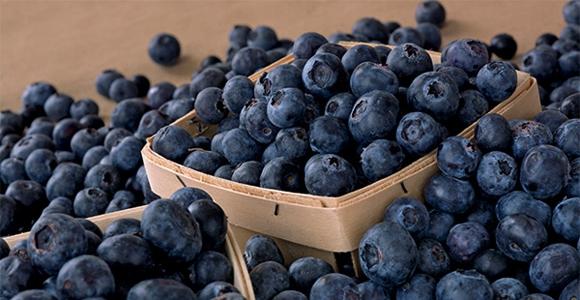Blueberry stem blight caused by the fungus Botryosphaeria dothidea and other Botryosphaeria species is the primary disease limiting the establishment of blueberry plantings in the southeastern United States.
Blueberry stem blight (dieback), caused by the fungus Botryosphaeria, is the most common disease causing death of young blueberry bushes in the southeastern United States. Both highbush and rabbiteye cultivars are susceptible to this disease. The fungus enters the plant through wounds and causes rapid death of individual canes and entire bushes. The disease is especially severe in 1- and 2-year-old plantings of susceptible cultivars.
Symptoms. Plants exhibit a rapid wilt with browning or reddening of leaves on individual branches, sometimes followed by death of the entire plant as the fungus spreads downward through vascular tissue to the base of the plant. Wilting occurs so rapidly that the stem does not defoliate before dying, resulting in “flagging,” a dead or dying stem with attached brown leaves. Stem blight symptoms generally first become evident in June, soon after harvest. Subsequent disease development can be observed throughout the summer months. Additionally, temperatures below 0 F have been observed to cause cracks in the forks of stems, resulting in wound-related epidemics early in the season
Disease Cycle. The disease may be introduced into a field on infected planting stock, with symptoms only becoming visible when plants are stressed by drought. Spread can also occur within fields when spores are carried by wind and rain from infected stems to wounds on healthy plants. The fungus is endemic in the southeastern United States and infects many other woody plants in addition to blueberry. All field-grown blueberry plants are exposed to this pathogen.
Management. Control of stem blight is managed through cultural methods such as site selection, the use of resistant cultivars, clean planting stock, nutrient management to avoid overfertilizing and subsequent winter injury, and selective pruning to remove infected canes. Fungicides do not generally provide adequate protection, but may be beneficial if applied immediately after pruning or other wounding events. Read more on the Stem Blight of Blueberry — Control.
Contact:
Bill Cline. NCSU Cooperative Extension Service.
References:
Cline, W.O. Stem Blight of Blueberry, Fruit Disease Information Note 9. 2000. Retrieved from http://www.ces.ncsu.edu/depts/pp/notes/Fruit/fdin009/fdin009.htm. 24 May 2010.
Cline, W.O., and Gina Fernandez. Suggestions for Establishing a Blueberry Planting in Western North Carolina. 1998. Retrieved from http://www.ces.ncsu.edu/depts/hort/hil/hil-201.html. 24 May 2010.
Cline, W.O., and Gina Fernandez. Principles of Pruning the Highbush Blueberry. 1998. Retrieved from http://www.ces.ncsu.edu/depts/hort/hil/hil-201-b.html. 24 May 2010.
Milholland, R.D. 1995. Botryosphaeria stem blight. Pages 10-11 in: Compendium of Blueberry Diseases. F.L. Carusa and D.C. Ramsdell, eds. APS Press, St. Paul, MN.

